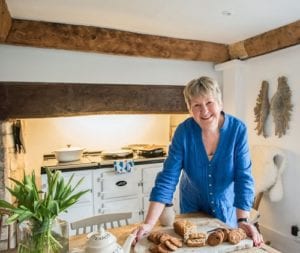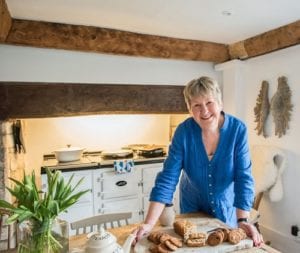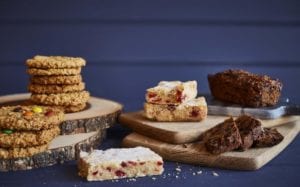
The Cake Whisperer - Val Stones - GBBO Contestant 2016 shares her top tips!

When I was a Head Teacher I baked ‘Friday treats’ for my staff. I let my lovely colleagues know that I could never repay them for all the care they gave to the children, but I could say thank you to them with my bakes.
Not content with having a bake each week, they decided to set me a challenge. The challenge: I must not repeat a bake!
With the challenge accepted and over the next five years, I went through my repertoire of traditional bakes. Victoria sponge, scones, tray bakes, pastries, biscuits and even puddings. However, there are 52 weeks in a year and with taking out the holidays that left me 38 weeks without being allowed to repeat a bake. And so, my twists on traditional bakes were born!
I put twists on my Victoria sponge, so they became coffee cakes with either coffee buttercream, or a decadent coffee liqueur Chantilly cream. I turned a sponge into a honey cake and a maple syrup cake too.
I created a lemon drizzle cake layered with luscious homemade lemon curd, and I also mixed the lemon sponge with an orange drizzle too.
Then, there was chocolate cake, with its endless extra flavours. Adding three tablespoons of homemade mincemeat created a light, but chocolatey, fruit cake.
To make sure everyone got a taste of my traditional bakes with a twist, I turned the above into cupcakes.
And I couldn’t forget scones in my baking challenge. I made plain, sultana, apple, followed by prune and almond, and pistachio and lemon. I tried maple syrup, (and honey). Can you see a pattern emerging?
Whatever I added to the Victoria sponge could be added to a scone.
Finally, there were cheese scones.

Over many years I have picked up hints and tips from various places, but here are some never fail recipe tips I want to share with you…
1. When I make a Victoria sponge, I use the “all-in-one method”. I weigh my eggs first so if four eggs out of their shells weigh 260g then into the bowl I weigh the same amount of caster sugar, then margarine. Lastly, I sift in self-raising flour, with an added 15g of baking powder. The order is important as the sugar on top of the egg begins to dissolve the sugar. The margarine comes next with the flour on top, so the air doesn’t get knocked out.
2. I use a stand mixer, but don’t start beating the mixture on full power straight away. Firstly, pulse on low until the mixture is combined - mostly so that you don’t get covered in flour. Beat for one minute and leave for 2 minutes whilst you grease the baking pans. I grease my pans with a propriety (600) cake release spray, but a little sunflower oil will do too. Continue to beat the mixture for 2 minutes only.
3. During any moments when you are waiting to start your next baking step, even if only for a couple of minutes, is where you do a little exercise, side steps and stretches are good. Whenever you are stood, waiting for the kettle to boil or stirring a pan, move or dance, it’s good for your body, and your soul.
4. I listen to my cakes to hear whether they are baked. The cake should not be silent, if it is, it is over baked. Instead it should crackle a little. If you take the cake out at this point the heat in the cake will continue to bake it for a further 2 minutes which is why you should let a cake stand for 2-4 minutes, in order for the cake to come to rest.
5. My tips for the lightest scones ever? Pre heat a baking sheet so that it is good and hot before you place the scones onto it to bake. If you do, the scones will begin to rise straight away.
6. Have all your scone ingredients at room temperature, this will speed up the rise (then there is no wasted heat having to raise the temperature of chilled ingredients). Use bread making flour as this gives a good structure to hold the scones as they rise. Instead of milk I use half double cream and half plain yoghurt, the lactic acid in the yoghurt activates the baking powder and gives it a boost for beautiful well risen scones. Sweet scones are given a beautiful colour and vanilla flavour by adding a tablespoon of custard powder. Lastly, adding the zest of a lemon really adds zing to a scone.
There is one thing that makes baking, and any challenges that colleagues may set me, even better is that I love baking with my grandchildren. When you bake with them you are creating memories. Bake shortbread biscuits and gingerbread biscuits as they are quick-and-easy. Be sure to have an endless variety of cutters available as children have fun using them in addition to decorating them. Simple cupcakes allow children to be creative, and of course they love eating them too. Baking jam tarts is also a favourite. My grandchildren really enjoy making the pastry and rolling it out. The best is the tradition of letting them ice a Christmas cake, from mixing the ingredients, to the icing. Let them add the “snow’ and all the decorations they wish.
Enjoy your very own challenge!
Stay up to date
Latest Blogs

Whole Home Comfort with Stannah and HSL

Dame Zandra Rhodes x Stannah: When accessibility meets style
Could more people benefit from home adaptation support for hidden disabilities?
50 years of Stannah Stairlifts – A milestone grounded in purpose

BBC’s Dr Punam Krishan reveals a little-known Parkinson’s symptom to watch for...

Are you at risk of falling? Dr. Punam Krishan’s simple 12-second test could tell you...

Snore Wars: Could sleeping separately be the secret to a better night’s rest?

Proud to carry the Made in Britain mark!
Stairlifts made for you
All our stairlifts whether straight or curved are customised to suit you and your home so call now to arrange a visit to get your FREE personalised quote!